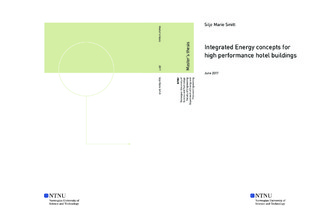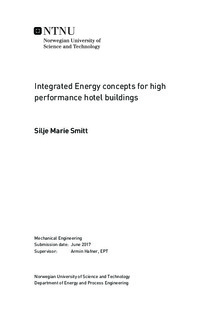| dc.description.abstract | On a national level, buildings are responsible for roughly 40% of the primary energy consumption, where domestic hot water and space heating are major contributors. By introducing an energy system that employs natural working fluids to cover all thermal demands, one is able to induce both economical and environmental benefits. The aim of this report is to reveal the energy related potential of a combined heat pump and refrigeration system intended for a hotel in Trondheim. Optimizing elements, such as heat recovery and thermal storage, have been included in the energy system.
The building simulation software Simien was utilized to create a model of the hotel, in order to estimate annual demands for space heating and cooling. Due to limitations in the software regarding transient operations, additional demand curves had to be constructed for domestic hot water, refrigeration and freezing loads. A model of the energy system was created in Dymola, where several simulations were carried out in order to investigate the performance and potential of the CO2 and propane heat pumps.
The simulations revealed that the purposed energy system is able to cover all thermal demands for the seasonal scenarios. The annual average energy efficiency for the CO2 system was found to be 5.55. By implementing thermal storage for space heating and cooling, the loads were reduced considerably in comparison to actual demand. The consequences of this being peak load reduction and a delayed of a few hours. The magnitude of the storage tanks limits the number of stops for the propane heat pump and enables a high efficiency for the system. A yearly average energy efficiency of 5.64 was found for the propane heat pump.
The energy system is highly efficient compared to more traditional heat pump solutions, and a considerable reduction in operational costs can be achieved. The current system design can be improved by reducing heat rejection to the ambient. In addition, the CO2 mid-pressure level should be increased for better performance. | |

